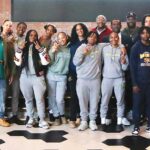WASHINGTON — George Scurlock Jr. remembers his grandfather, always clad in a suit and tie, meticulously posing subjects and setting lights to ensure his photographs of Washington’s black community reflected its dignity and ambition.
Addison Scurlock and later two of his sons, including George Scurlock’s father, ran a successful studio from 1911 to 1994. During that time, they captured the growth of a vibrant black middle class that thrived culturally and economically despite segregation. Later, the sons pictured the civil rights movement and then the riots that damaged once-flourishing neighborhoods.
“There was a professional and operating culture within the black community that … had bountiful resources and beauty associated with it that I just don’t think white America has an awareness of,” said George Scurlock Jr.
The era they chronicled now appears in about 100 photographs and other items in the exhibit, “The Scurlock Studio and Black Washington: Picturing the Promise,” at the Smithsonian Institution’s National Museum of American History.
Curators say the Scurlocks’ confident and sophisticated portrayal of upwardly mobile black people helped counter negative stereotypes.
“You have these images that are representing the beauty of black folks, the dignity of African Americans not just in contrast to racist imagery, but the way in which people want to see themselves,” noted Paul Gardullo, museum curator of the National Museum of African American History and Culture, which helped curate the exhibit.
Several other black studio photographers also documented their communities’ middle and upper middle classes. Among them were James VanDerZee and James Latimer Allen in New York City; Daniel L. Freeman in Washington; Cornelius M. Battey and his student, P.H. Polk, in Tuskegee, Ala.; and Arthur P. Bedou in Louisiana.
Curators hope that showcasing the work of Addison Scurlock and his sons, Robert and the elder George, will help make the family studio more widely known.
“[Addison] Scurlock has never achieved the national presence in the history of photography that I think is deserved,” said Michelle Delaney, associate curator of photography at the American history museum.
After training with Moses P. Rice, a prominent white photographer, Scurlock opened his studio in a bustling black neighborhood in northwest Washington. His sons later joined, learning their father’s signature style — the “Scurlock look,” which used soft focus, retouching, overhead and strobe lighting and careful positioning of a subject’s face and body to create flattering profiles.
Mamie Fearing Scurlock, Addison’s wife, managed the studio’s business and finances.
The exhibit shows the Scurlocks’ many images of families, weddings, businesses, graduations and social groups through nearly a century. The famous also made up their clientele. Portraits of prominent black figures such as W.E.B. Du Bois and Booker T. Washington, and jazz great Duke Ellington line the exhibition’s walls.
The photos speak of a black community that blossomed in the face of adversity. A panoramic shot shows dapper crowds near a carnival ride at Suburban Gardens Amusement Park, created in northeast Washington after black people were barred from Glen Echo Park in Maryland. (The Suburban Gardens park closed in 1940.)
The Scurlocks maintained close ties with Howard University, an integral institution of the black middle class. They served as official photographers for the historically black university for almost 90 years.
Visitors can see photos of scientists, students studying or square-dancing, and dignitaries such as President John F. Kennedy and Martin Luther King Jr., both of whom visited the school.
Addison Scurlock occasionally stepped outside studio portraiture, as seen in a photo of a mass baptism on the Potomac River, and even experimented with his style. But his work seldom covered unscripted moments or the poorer sections of Washington.
His sons, George and Robert, carried on their father’s techniques and values. But the brothers also branched out, using documentary photography to capture more spontaneous moments and grittier subject matter. That’s evident in their photos of the riots following King’s 1968 assassination.
It can also be seen in a rare undated photo from the Scurlock studio in which children play in a littered alley behind row houses. They’re stepping on garbage as a clothesline hangs above, and the U.S. Capitol dome looms in the distance.
Curators say the photo was likely taken by Robert Scurlock in the 1970s; the area may be southwest Washington before it was razed and redeveloped.
Besides photographs, museum-goers can see bulky cameras, advertising signs, client record books and props used in the Scurlock studio.
A fur coat worn by opera contralto Marian Anderson is also on display. It’s the same coat Anderson wore in a Scurlock photo hanging nearby, taken when she performed at the Lincoln Memorial in 1939. The black singer was banned from Constitution Hall by the Daughters of the American Revolution, but thousands gathered at the memorial — with an assist from first lady Eleanor Roosevelt — as she sang “My Country, ’Tis of Thee.”
Addison Scurlock died in 1964, but son Robert kept the studio going until his death in 1994. George Scurlock, who had left the business in the late 1970s, died in 2005.
George Scurlock Jr., 61, who works as a diversity consultant in Hartford, Conn., helped make photo proofs at his family’s studio as a boy. He said his grandfather, father and uncle ran their studio without realizing they were documenting history.
“It wasn’t seen as special at the time; it was just another black-owned business on U Street,” he says. “But that doesn’t diminish the pride we have.”
The exhibit runs through Nov. 15. The gallery housing the Scurlock work will continue to feature exhibits for the Smithsonian’s African American history museum, which is scheduled to open in 2015.
(Associated Press)




![Banner [Virtual] Art Gallery](https://baystatebanner.com/wp-content/uploads/2024/04/NJ-H_1-713x848.jpg)

